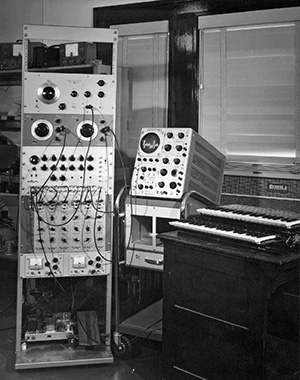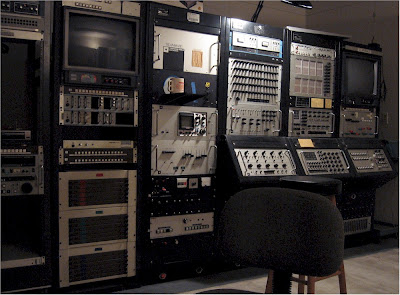
Showing posts sorted by date for query Computer History Archives Project. Sort by relevance Show all posts
Showing posts sorted by date for query Computer History Archives Project. Sort by relevance Show all posts
Thursday, March 02, 2023
Synth Rorschach #84
What is it?
See the video below.
Note the patch points appear to be mini pins in to banana plug type sockets.
P.S. Akai gets a label for this one.
LABELS/MORE:
Akai,
Breadboard,
eurorack,
Fairlight,
Interviews,
LZX,
New Updates,
Synth Rorschach,
Updates,
Video Processing,
Video Synths
Wednesday, April 27, 2016
The Harmonic Tone Generator from 1964
You might remember James Beuchamp's Harmonic Tone Generator posted back in December (be sure to see that post for other bits of synth history). Skot Wiedmann, the man behind Motus Mavis and the Hyve touch synthesizer, wrote in to let us know a new article on the story behind the Harmonic Tone Generator, including an NPR piece, just went up today on the University of Illinois' Public Media website here. Be sure to click through for the audio and the full post. Below is just an excerpt for the archives.
"One of the earliest synthesizer structures was invented in the University of Illinois’ Experimental Music Studio in the early 1960s as part of one of the first computer instruments – The Harmonic Tone Generator.
From Left to Right: The Original Harmonic Tone Generator, James Beauchamp constructing the Harmonic Tone Generator, a close up of one of the original instrument's panels
James Beauchamp sits at a workbench tuning three circuit boards before installing them in the Harmonic Tone Generator. This picture was taken in 1964.
Photo Credit: Courtesy of James Beauchamp
“A lightbulb went off and I decided: we build electronics for audio, we record using electronics in playback, but what about making music or sounds from electronics to begin with?” said James Beauchamp, a research professor in the Department of Electrical and Computer Engineering at the University of Illinois.
He completed the Harmonic Tone Generator in 1964 as part of his PhD project in electrical engineering."
Pictured: "James Beauchamp sits at a workbench tuning three circuit boards before installing them in the Harmonic Tone Generator. This picture was taken in 1964.
Photo Credit: Courtesy of James Beauchamp"
Pictured: "The original Harmonic Tone Generator and its next generation counterpart side by side in the Sousa Archive
Photo Credit: Courtesy of Mark Smart"
Friday, December 20, 2013
Trash Secret - A Musical Journey Inside Technology on Kickstarter
Synth bits come in at 2:35 followed by 3:15.
From the man who brought us the PetSynth back in October of 2009, Chrion Bramberger has a new project with a campaign on Kickstarter here. As you can see from the video above, the focus is on making art, music and instruments from discarded electronic equipment. Click through to the Kicstarter campaign for full details. Backers of the project will be entitled to sample sets and some of the unique gear created for the project.
The following is a sizable excerpt on the gear for the archives (not everything is captured so be sure to click through to the campaign for more including additional pics and history on each item):
"Musical Instruments - Hardware and Software
Effects Pedals for Guitars:
The Dragonfly
A distortion pedal made from a recycled modem and hard drive
A New Top-Secret Design
A unique pedal, mono synth-like, but neither truly analog or digital [some additional bits from the kickstarter page: 'I can't give it all away, but I've done something totally new. I've created a pedal that makes your guitar sound crazy! It's hard to describe, but it has an 8-bit feel to it, and is best compared to a mono-synth. However, it is neither digital nor analog. It uses chips from a DEC PDP-11 computer, but it does naughty things with them. Horribly naughty and inappropriate things that these chips were never meant to do. :-)
I took my inspiration from Woz (Steve Wozniak - co-founder of Apple) and they way he designed his blue box to generate more tones than it should because he was able to exploit properties of the chips weren't supposed to generate more sounds, but did. This is my humble attempt at a clever hack, in homage to Woz and his amazing Mozart-like ability to explore circuits in his head to do new things.
This is my newest design, and this pedal is still in the breadboard stage.
However, this pedal will benefit from all the work and experience from building the prototypes from The Dragonfly. It will have a similar size and shape, use a hard drive for a case, an acrylic faceplate, and take advantage of my unique super-secret full color plastic printing techniques.']
PetSynth and MIDI adapter for Vintage Computers
Commodore PET
Commodore VIC-20
Commodore 64
Based on the original PetSynth software I created. A monophonic synth, and hardware adapter to provide a MIDI interface, for Commodore computers. Connects through the user port on Commodore computers. Helps unlock previously unused voices on the above computers.
Nintendo Entertainment System (NES)
Based on the original PetSynth software I created. A monophonic synth, and hardware adapter to provide a MIDI interface, for the original NES. A typical cartridge provides the software. MIDI connects through the controller port on the NES. The cartridge does not have special hardware, or any wires that hang out of the front of the NES, and will be released as open-source.
BBC Micro
Based on the original PetSynth software I created. A monophonic synth, and hardware adapter to provide a MIDI interface, for Commodore computers. Connects through the a port on BBC Micro computers (user port or parallel port to-be-determined).
Apple IIGS Stereo Card
A stereo adapter for the Apple IIGS. Originally designed from a multiplexing chip found in CD-ROM’s. New design from better multiplexers found in some KVM switches will be implemented. Will connect to the internal sound expansion port in the IIGS. There is the possibility of a board that fits between the sound chip and motherboard, to provide better sound quality and balanced outputs. However, not all Apple IIGS systems have a socketed sound chip (some are soldered) and the feasibility needs to be further explored. Exact details to-be-determined, but a demo of the original design can be seen and heard in the Kickstarter video (above).
Guide to Macro Technology Photography and How to use and old CD-ROM to take Microscopic Pictures on a Mobile Phone
A guide that helps people to use their camera or mobile phone to take pictures like the ones seen in the Kickstarter video (above). This would include macro photography tips and tricks, as well as a guide to using an old CD-ROM to safely modify a mobile phone camera to act as a microscope. This process is not permanent, and the mobile phone is not taken apart or damaged. Can be done by anyone easily with this guide.
Musical Instruments - Sampler Patches
Supported Software
Logic & Garage Band
Kontact
Raw sample files for users to import into their own samplers.
Organic Acoustic & EMF Sounds
Samples of acoustic and electromagnetic sounds of computers, video games and technology, and soft synth patches created for mainstream samples. How many patches, and what will be samples, will be determined through the process of creating the album. Expect approximately 10 or more unique patches. This may be the sounds of hitting or bowing hard drive platters, heat sinks, and other parts of old computer and electronics.
Samples of Hardware and Software projects (above) as Soft Synths
Samples of various computers, electronics, and video game parts, and software synth patches
Systems Sampled:
Commodore PET
Commodore VIC-20
Commodore 64
Nintendo Entertainment System (NES)
BBC Micro
Apple IIGS created Instruments sampled
Selected Guitar sound samples and hits through the Effects Pedals in this project: The Dragonfly and the New Yet Unnamed effect"
Pictured below:
Top: The Dragonfly Guitar Pedal
Middle: New Top-Secret Design Pedal
Bottom: The PetSynth MIDI adapter

Wednesday, February 01, 2012
The Scanimate
Moog Little Phatty and the Scanimate
YouTube Uploaded by experimentalsynth on Feb 1, 2012
"The first attempt at controlling analog video animation with control voltage created by a Moog synthesizer. Learn more at www.scanimate.com and www.experimentalsynth.com"
"Scanimate is a 100% analog video animation system in use form the late 60s to early 80s. It was used on a number of popular films & TV shows including, Star Wars, Logan's Run, Sesame Street & NBC Sports. Only eight were built and they originally sold for around $1,000,000."
Looks like an ARP 2500 style slider matrix in there.
via www.scanimate.com where you'll find additional details.
"Dave Sieg gave a talk at NotaCon in Cleveland, OH April 14, 2011 about Scanimate. 'The history of digital computer animation is fairly well documented, but considering that the 8 Scanimate analog computers ruled the airwaves for almost a decade, there has been very little written or revealed about them." Tracing his machine's roots back as far as the whirlwind project and some of the early work by Ivan Sutherland, Sieg showed a variety of clips from his archives to explain how animation was produced back in the days when an animator had to be an analog circuit design engineer.'"
YouTube Uploaded by experimentalsynth on Feb 1, 2012
"The first attempt at controlling analog video animation with control voltage created by a Moog synthesizer. Learn more at www.scanimate.com and www.experimentalsynth.com"
"Scanimate is a 100% analog video animation system in use form the late 60s to early 80s. It was used on a number of popular films & TV shows including, Star Wars, Logan's Run, Sesame Street & NBC Sports. Only eight were built and they originally sold for around $1,000,000."
Looks like an ARP 2500 style slider matrix in there.
via www.scanimate.com where you'll find additional details.
"Dave Sieg gave a talk at NotaCon in Cleveland, OH April 14, 2011 about Scanimate. 'The history of digital computer animation is fairly well documented, but considering that the 8 Scanimate analog computers ruled the airwaves for almost a decade, there has been very little written or revealed about them." Tracing his machine's roots back as far as the whirlwind project and some of the early work by Ivan Sutherland, Sieg showed a variety of clips from his archives to explain how animation was produced back in the days when an animator had to be an analog circuit design engineer.'"
HOME













© Matrixsynth - All posts are presented here for informative, historical and educative purposes as applicable within fair use.
MATRIXSYNTH is supported by affiliate links that use cookies to track clickthroughs and sales. See the privacy policy for details.
MATRIXSYNTH - EVERYTHING SYNTH













© Matrixsynth - All posts are presented here for informative, historical and educative purposes as applicable within fair use.
MATRIXSYNTH is supported by affiliate links that use cookies to track clickthroughs and sales. See the privacy policy for details.
MATRIXSYNTH - EVERYTHING SYNTH

































